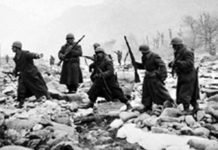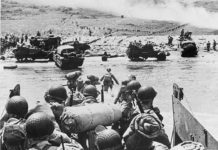During the Spanish Civil War some 300,000 people die; mostly, innocent victims murdered by both the Nationalist and the Republican forces.
Brought about mainly by Ernest Hemingway’s stand on the three year (1936-1939) conflict – he was pro Republican – the atrocities committed by the right-wing Nationalists are better known. But the Republicans were just as ruthless in the elimination of anybody considered an opponent.
A Brief History of the Spanish Civil War
Inthe years between the wars, Spain experienced economic hardships which led to political violence. Due to the Great Depression, the situation got considerable worse in the 1930s; politically motivated assassinations, strikes, riots, they were all part of daily Spanish life at this time.
From the moment the Spanish Second Republic government took office on April 14, 1931, it faced opposition from both the left and the right.
The conflict erupted when the armed forces revolted on July 17, 1936 against the elected government of the leftist Popular Front. Siding with the military were the Catholic Church, the right wing Falange (Phalanx) militias, business and land owners, as well as what was left of those in the political center.
On the other side were anarchists, urban workers, the small Communist party and a good portion of the middle class.
Within four days, the rebel Nationalist had taken over the Canary Islands, Spanish Morocco, and most of the Balearic Islands and the region north of the Ebro River. They also had strong backing in the south where they controlled the cities of Seville, Granada and Córdova.
The Nationalists, eventually lead by General Francisco Franco, received help from Nazi Germany and Fascist Italy; the Republicans from Marxist Soviet Union as well as France and México. About 60,000 foreigners either volunteers for the international brigades or served in medical units on the Republican side.
In no time the struggle took an international character. It was considered a fight between Marxism and culture; or between Fascism and liberty; or between democracy and dictatorship.
The Spanish Civil War also became one of the most horrendous examples of fratricide the world has ever known. Both sides executed supposed enemies without trial, raped, tortured, kidnapped, looted and burned.
Atrocities Committed by the Right
Between 50,000 and 200,000 non combatants were killed by the Nationalist during the war. Most of the carnage took place during the first five months of the uprising.
Some of the best known cases are:
– The bombing of civilians in such cities as Madrid, Barcelona and others. Most of the aerial attacks were conducted by the Condor Legion of the Luftwaffe and the Italian air force. Between anywhere from 5,000 to 10,000 people were murdered in this fashion. The most infamous bombing was that of the Basque town of Guernica, immortalized by a painting of Pablo Picasso. At the time, it was believed that about 1, 600 died. Since the number of victims has been scaled down to between 200 and 400 victims.
– Massacre of Badajoz. In this town of the Spanish southwest, the Nationalists summarily executed supporters of the Republic on August 14, 1936. Estimates run from 1,300 to 4,000 victims.
– Assassination of the poet Federico García Lorca. On August 19, 1936, Nationalist militias disposed of Lorca and three others near Granada. This was a strange murder for Lorca, even though a liberal, has expressed support for the Nationalists. The killing of Lorca might not have been political but motivated by homophobia for he was a known homosexual.
The murderous behavior of the right became known as the White Terror.
After the war, the Franco regime executed thousands of former Republican sympathizers, anywhere from 20,000 to 35,000.
Atrocities of the Left
The Spanish left gave as well as it took. In the period known as Terror Rojo (Red Terror), which roughly coincides with the White Terror, the Republicans took from 38,000 to110, 000 innocent lives.
Most infamous activities of the Red Terror include:
– Murder of Catholic clergy. In the course of the war 6,832 clergymen, including 13 bishops, and 283 nuns (many tortured) were killed.
– Hundreds of Catholic churches and synagogues were burned, pillaged or closed. Remarkably a number of small Protestant churches were respected.
– Paracuellos massacre. Between November and December of 1936, Republican militias put to death between 2,000 and 12,000 Nationalist sympathizers. The slaughter took place during the Battle of Madrid in Paracuellos del Jarama, a small town on the outskirts of the Spanish capital.
– Murder of Ramiro de Maetzu. A writer, literary critic and diplomat, de Maetzu was a member of the prestigious literary movement known as the Generation of 98. A socialist at first, de Maetzu’s experiences during World War I changed him. He became a conservative and traditionalist co-founding a monarchist party, Acción Española. Ramiro de Maetzu was shot near Madrid on October 29, 1936 by Republican forces.
Aftermath of the Conflict
The victor’s leader, Franco, would rule Spain with an irons fist until his death in 1975. Many a sympathizers of the defeated Nationalists would suffer imprisonment, torture and death.
The country was bankrupt and its industrial base as well as military power would fall behind the rest of Europe. Spain was diplomatically ostracized by the Western powers.
Franco, however, would keep Spain out of World War II and eventually, sign a treaty with the United States that would bring the country out of its economic and political doldrums.








